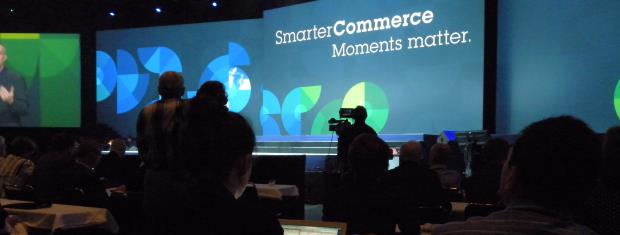TAMPA BAY – There’s an e-word tossed around a lot here at this week’s IBM’s SmarterCommerce conference, and it’s not e-commerce: It’s “experience.”
Almost every presentation by an IBM official and almost every case study from a customer includes the word to the point where it’s almost worn out.
“Experience is the new North Star,” Paul Papas, global leader of IBM’s Interactive Experience consulting practice told the conference Wednesday.
But an industry analyst says it’s a useful shorthand for what organizations are looking for: Ways to make online buying – by suppliers or consumers – easier.
“I do feel that these days when we move so fast … a 20 minute phone conversation is not going to sell,” Heather Ashton, research manager for the manufacturing industry at IDC Insights. “I want to get online, where I need to go, get the product, order it.”
In their presentations organizations have highlighted how they are using IBM technology to delve into customer and supplier data to give buyers a better – wait for it – experience.
They include
–Casual clothes retailer Abercrombie & Fitch, whose Hollister brand targets younger buyers with a range of techniques mostly for mobile platforms. One is the creation of a fictional, but ideal teen customer who in a video calls herself a tomboy. The company then invites viewers to send in videos of themselves in tomboy moments.
Billy May, A&F’s group vice-president for digital and customer marketing, told the conference the company’s goal is to create “snackable moments” – brief campaigns that cater to short attention spans of younger buyers. The campaigns have modular pieces that can change as expectations of customers alter.
“Context as well as content is truly king,” he said. “You’ve got to create a spark that connects emotionally with customers.”
—Fausto Hernandez Pintado, chief strategic planning and value creation officer at Banorte, Mexico’s third largest bank with 26 million clients, explained how analytics helped segment the institution’s customers to discover their preferred customers use the Internet for banking. That led the bank to more targeted marketing;
— Britain’s Homebase home improvement and décor chain is overhauling its online presence to create “moments of inspiration” and “moments of connection,” according to director of marketing Jo Kenrick.
For example, it created an app allowing people to snap a pic with a smartphone of an area of a garden they want to update and upload it to the company. Staff send back recommendations, including a list of products and their bar codes. Customers are also asked to send in simple home improvement recommendations, which are then posted on the Web site.
It also created an app lets shoppers send in a photo from a smart phone of a space in a garden to be improved. Staff recommend what to put there, plus add a bar code for products so when the shopper comes to a store the right one is picked.
—Allstate Insurance has a number of mobile-based customer loyalty tactics, according to Sanjay Gupta, executive VP marketing, innovation and corporate relations. These include an app that can monitor driving habits so the company can reward good drivers; an app that monitors teen drivers so parents can have some peace of mind when children are behind the wheel alone (and it earns the teens points); and an app that lets customers have a video chat with a claims adjuster right after an accident to speed up the process.
Allstate produces marketing that engages with customers, Gupta said, not necessarily push products. “We can use technology to advance the customer experience,” he said.
“The interesting thing to me is that manufacturers are coming to us saying, ‘We need to enhance our customer experience,’” says IDC’s Ashton – meaning their suppliers and distributors, as well as customers they sell directly to.
Some staff resist. She recalls being at a recent roundtable where a company said its direct sales force believed it “owned” the customer. But after shifting to an indirect sales model it found customer satisfaction improved – they liked being able to go online for self-serve help, and contacted inside sales staff when necessary.
Stories like that reinforce the “experience” approach.
Ashton does caution that an organization looking for technology to get closer to customers have to take a unified approach. Too many companies have different branches or divisions buying solutions, which doesn’t help in bringing a single focus for the brand.
In addition, marketing and/or sales alone can’t lead the search. Departments such as procurement, finance and other stakeholders also need to be involved, she said, so a holistic solution can be found to craft the best customer experience.






